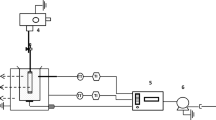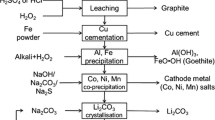Conclusions
-
1.
Increasing the temperature increases the degree of decomposition of the sulfurous compounds in the crude stock, in which case the sulfur concentration in the liquid cracking products increases.
-
2.
Decreasing the specific, gravimetric flow rate not only increases the degree of decomposition of the sulfurous compounds of the crude stock but also results in a decrease in the sulfur concentration in the liquid cracking products because of the occurrence of secondary desulfurization reactions.
-
3.
Increasing the number of sections both for identical conditions and for the same degree of decomposition of the crude stock also increases the extent of decomposition of the sulfurous compounds and results in a desulfurization of the liquid cracking products. Upon increasing the number of sections, the amount of sulfur which is removed with the coke and gas also increases.
-
4.
For the same conditions the greater the activity of the catalyst, the greater the extent of decomposition of the sulfurous compounds. Mainly, this takes place because of the more extensive decomposition of the crude stock itself.
-
5.
For the same degree of decomposition of the crude stock and the same number of sections a different rule is observed. On the low-active, natural catalyst the decomposition of the sulfurous compounds of the crude stock takes place to a greater degree than on the synthetic catalyst but in this case a significant part of the decomposed sulfurous compounds is converted into the naphtha and light gas oil whereas on the synthetic catalyst the sulfur is removed more with the gas and coke than in the case for the natural catalyst. This indicates a smaller amount of secondary reactions for the cracking on the natural catalyst.
-
6.
In cracking crude stock with a larger concentration of aromatic hydrocarbons (mainly heavy aromatic hydrocarbons) the sulfur which passes into the naphtha and light gas oil is greater than for the cracking of the less aromatic crude stock with predominantly light and medium aromatic hydrocarbons.
Similar content being viewed by others
Literature cited
B. T. Abaeva and E. S. Aramyan, Methods of Studying Petroleum Products [in Russian], Gostoptekhizdat (1955).
A. V. Agafonov, B. T. Abaeva, and N. A. Okinshevich, Chemistry of Sulfur- and Nitrogen-Containing Organic Compounds Present in Petroleums and Petroleum Products [in Russian], Vol. III, UFAN (1960).
R. S. Livshits, Candidate's Dissertation, I. M. Gubkin Moscow Institute of Petroleum Chemistry and Gas Processing (1960).
D. I. Orochko, S. V. Adel'son, et al., Khim. i Tekhnol. Topliv i Masel, No. 4 (1959).
T. Kh. Melik-Akhnazarov, D. I. Orochko, et al., in: Methods for Intensifying the Basic Processes in the Oil Refining Industry in Relation to the Prospects for its Development [in Russian], TsNIITEneftegaz (1964), p. 206.
J. W. Schall and J. C. Dart, Petr. Ref.,31, No. 4, 173–176 (1952).
T. Kh. Melik-Akhnazarov, R. S. Livshits, D. I. Orochko, and G. S. Shnaider, Theses of Reports to the Scientific-Technical Conference, Use of Fluidized Beds in Chemical Industry [in Russian], Izd. Khimiya (1965).
T. Kh. Melik-Akhnazarov, R. S. Livshits, D. I. Orochko, and G. S. Shnaider, Khim, i Tekhnol. Topliv i Masel, No. 12 (1965).
Additional information
Deceased.
Translated from Khimiya i Tekhnologiya Topliv i Masel, No. 10, pp. 1–6. October, 1972.
Rights and permissions
About this article
Cite this article
Livshits, R.S., Melik-Akhnazarov, T.K. & Orochko, D.I. Rules for the distribution of sulfur among the products of Stag-Countercurrent Catalytic Cracking (SCCC). Chem Technol Fuels Oils 8, 727–732 (1972). https://doi.org/10.1007/BF00717064
Issue Date:
DOI: https://doi.org/10.1007/BF00717064




